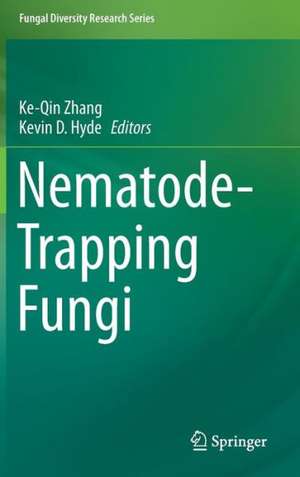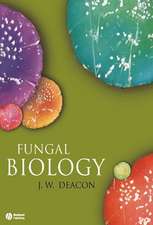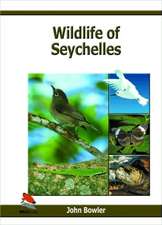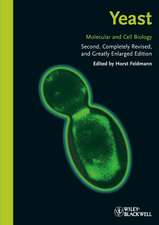Nematode-Trapping Fungi: Fungal Diversity Research Series, cartea 23
Editat de Ke-Qin Zhang, Kevin D. Hydeen Limba Engleză Hardback – 8 mai 2014
Nematode-trapping fungi with adhesive or mechanical hyphal traps are the main focus of this book which begins with an overview of the data on nematode-trapping fungi, including their taxonomy, phylogeny and evolution. Subsequent chapters expand upon the methods and techniques used to study these fascinating fungi. Keys for genera of Arthrobotrys, Drechslerella and Dactylellina, which include all reported species of predatory orbiliaceous fungi are presented and numerous species from these genera are morphologically described and illustrated.
The ecology ofnematode-trapping fungi is expertly presented: their occurrence and habitats, their geographical and seasonal distribution and the effects of soil conditions and nematode density on their distribution all feature amongst the relevant themes.
Further chapters examine the use of nematode-trapping fungi in biological control and the authors consider nematicidal activities in detail, exploring the many compounds from fungi that feature in nematicidal activities and of course useful paths for further study on this topic.
This is a highly informative and carefully presented book, providing scientific insight for scholars with an interest in fungi and in biological control of nematodes.
| Toate formatele și edițiile | Preț | Express |
|---|---|---|
| Paperback (1) | 949.73 lei 6-8 săpt. | |
| SPRINGER NETHERLANDS – 3 sep 2016 | 949.73 lei 6-8 săpt. | |
| Hardback (1) | 954.93 lei 6-8 săpt. | |
| SPRINGER NETHERLANDS – 8 mai 2014 | 954.93 lei 6-8 săpt. |
Preț: 954.93 lei
Preț vechi: 1164.56 lei
-18% Nou
Puncte Express: 1432
Preț estimativ în valută:
182.72€ • 199.11$ • 153.97£
182.72€ • 199.11$ • 153.97£
Carte tipărită la comandă
Livrare economică 23 aprilie-07 mai
Preluare comenzi: 021 569.72.76
Specificații
ISBN-13: 9789401787291
ISBN-10: 9401787298
Pagini: 404
Ilustrații: XI, 392 p. 137 illus., 14 illus. in color.
Dimensiuni: 155 x 235 x 27 mm
Greutate: 0.72 kg
Ediția:2014
Editura: SPRINGER NETHERLANDS
Colecția Springer
Seria Fungal Diversity Research Series
Locul publicării:Dordrecht, Netherlands
ISBN-10: 9401787298
Pagini: 404
Ilustrații: XI, 392 p. 137 illus., 14 illus. in color.
Dimensiuni: 155 x 235 x 27 mm
Greutate: 0.72 kg
Ediția:2014
Editura: SPRINGER NETHERLANDS
Colecția Springer
Seria Fungal Diversity Research Series
Locul publicării:Dordrecht, Netherlands
Public țintă
ResearchCuprins
Preface.- Abstract.- 1. Nematode-Trapping Fungi.- 2. Methodology for Studying Nematophagous Fungi.- 3. Taxonomy of Nematode-Trapping Fungi from Orbiliaceae, Ascomycota.- 4. The Ecology of Nematophagous Fungi in Natural Environments.- 5. Biological Control of Plant-Parasitic Nematodes by Nematophagous Fungi.- 6. Molecular Mechanism of Nematophagous Fungi Infection of Nematodes.- 7. Nematode-Toxic Fungi and their Nematicidal Metabolites.- 8. Future Study.- Index.
Textul de pe ultima copertă
These chapters provide up-to-date information on nematophagous fungi, particularly those of the Orbiliaceae in Ascomycota, whose asexual states produce nematode-trapping devices. The authors consider fungal-nematode interactions, fossil fungi, the biodiversity, ecology and geographical distribution of nematode-trapping fungi, and their potential use in biocontrol of nematodes, all in detail.
Nematode-trapping fungi with adhesive or mechanical hyphal traps are the main focus of this book which begins with an overview of the data on nematode-trapping fungi, including their taxonomy, phylogeny and evolution. Subsequent chapters expand upon the methods and techniques used to study these fascinating fungi. Keys for genera of Arthrobotrys, Drechslerella and Dactylellina, which include all reported species of predatory orbiliaceous fungi are presented, and numerous species from these genera are morphologically described and illustrated.
The ecology of nematode-trapping fungi is expertly presented: their occurrence and habitats, their geographical and seasonal distribution and the effects of soil conditions and nematode density on their distribution all feature amongst the relevant themes.
Further chapters examine the use of nematode-trapping fungi in biological control and the authors consider nematicidal activities in detail, exploring the many compounds from fungi that feature in nematicidal activities and of course useful paths for further study on this topic.
This is a highly informative and carefully presented book, providing scientific insight for scholars with an interest in fungi, and in biological control of nematodes.
Nematode-trapping fungi with adhesive or mechanical hyphal traps are the main focus of this book which begins with an overview of the data on nematode-trapping fungi, including their taxonomy, phylogeny and evolution. Subsequent chapters expand upon the methods and techniques used to study these fascinating fungi. Keys for genera of Arthrobotrys, Drechslerella and Dactylellina, which include all reported species of predatory orbiliaceous fungi are presented, and numerous species from these genera are morphologically described and illustrated.
The ecology of nematode-trapping fungi is expertly presented: their occurrence and habitats, their geographical and seasonal distribution and the effects of soil conditions and nematode density on their distribution all feature amongst the relevant themes.
Further chapters examine the use of nematode-trapping fungi in biological control and the authors consider nematicidal activities in detail, exploring the many compounds from fungi that feature in nematicidal activities and of course useful paths for further study on this topic.
This is a highly informative and carefully presented book, providing scientific insight for scholars with an interest in fungi, and in biological control of nematodes.
Caracteristici
Collates and presents data on nematode-trapping fungi and describes their ecology Examines the use of nematode-trapping fungi in biological control Explores the mechanisms involved in nematicidal activities and considers how these can be further explored Includes supplementary material: sn.pub/extras














